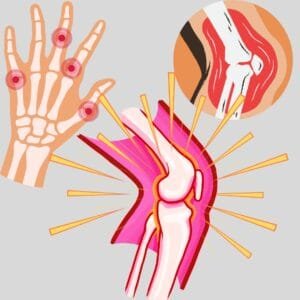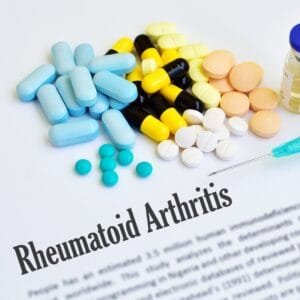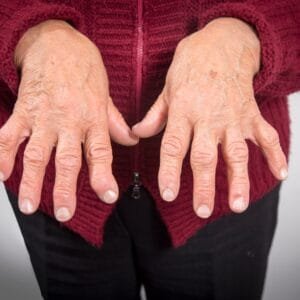Rheumatoid Arthritis: Causes, Symptoms, and Treatment
Rheumatoid Arthritis (RA) is a chronic autoimmune disorder that primarily affects the joints, causing pain, swelling, stiffness, and reduced mobility. Unlike osteoarthritis, which is caused by wear and tear, RA occurs when the immune system mistakenly attacks the body’s tissues, leading to inflammation and potential joint damage. Early diagnosis and treatment are essential for managing symptoms and preventing long-term complications.



What is Rheumatoid Arthritis?
Rheumatoid arthritis is a systemic autoimmune disease that not only affects joints but can also impact other parts of the body, such as the skin, eyes, heart, and lungs. It typically affects multiple joints symmetrically, such as both wrists or knees. Over time, chronic inflammation can lead to joint deformity and loss of function.
RA is more common in women than men and often develops between the ages of 30 and 60, although it can occur at any age.
Causes of Rheumatoid Arthritis
The exact cause of RA remains unclear, but several factors are believed to contribute:
1. Immune System Dysfunction
- The immune system attacks the synovium (the lining of joints), leading to inflammation and tissue damage.
2. Genetic Predisposition
- Certain genetic markers, such as HLA-DR4, increase susceptibility to RA.
3. Environmental Triggers
- Factors like infections, smoking, or exposure to pollutants may trigger the onset of RA in genetically predisposed individuals.
4. Hormonal Factors
- Hormonal changes, such as those during pregnancy or menopause, may influence RA development.
Symptoms of Rheumatoid Arthritis
RA symptoms vary in severity and may progress over time. Common symptoms include:
Joint-Related Symptoms
- Pain and Swelling:
- Joints become tender, warm, and swollen.
- Stiffness:
- Especially in the morning or after periods of inactivity.
- Redness and Warmth:
- Affected joints may appear inflamed.
- Decreased Range of Motion:
- Difficulty performing daily activities due to joint stiffness.
Systemic Symptoms
- Fatigue:
- Persistent tiredness, even with adequate rest.
- Low-Grade Fever:
- Inflammation may cause mild fever.
- Loss of Appetite:
- A result of systemic inflammation or discomfort.
- Nodules:
- Firm lumps under the skin near affected joints.
Complications of Rheumatoid Arthritis
If left untreated, RA can lead to severe complications:
- Joint Damage and Deformity:
- Erosion of cartilage and bone.
- Osteoporosis:
- Inflammation and medications may weaken bones.
- Rheumatoid Nodules:
- Lumps under the skin in pressure areas.
- Organ Involvement:
- RA can affect the heart, lungs, eyes, and blood vessels.
- Increased Risk of Infections:
- Due to weakened immunity or certain RA treatments.
Diagnosis of Rheumatoid Arthritis
Diagnosing RA requires a combination of medical history, physical exams, and diagnostic tests:
- Physical Examination:
- Assess joint tenderness, swelling, and range of motion.
- Blood Tests:
- Rheumatoid Factor (RF): An antibody present in many RA patients.
- Anti-Citrullinated Protein Antibody (ACPA): Highly specific for RA.
- Erythrocyte Sedimentation Rate (ESR) and C-Reactive Protein (CRP): Indicate inflammation levels.
- Imaging Tests:
- X-rays: Detect joint damage or erosion.
- MRI and Ultrasound: Identify early inflammation and tissue damage.
Treatment Options for Rheumatoid Arthritis
Although there is no cure for RA, treatment focuses on controlling inflammation, relieving symptoms, and preventing joint damage. Common approaches include:
Medications
- Disease-Modifying Anti-Rheumatic Drugs (DMARDs):
- Slow disease progression and prevent joint damage (e.g., methotrexate, sulfasalazine).
- Biologic Agents:
- Target specific parts of the immune system (e.g., adalimumab, etanercept, rituximab).
- Nonsteroidal Anti-Inflammatory Drugs (NSAIDs):
- Relieve pain and reduce inflammation (e.g., ibuprofen, naproxen).
- Corticosteroids:
- Quickly reduce inflammation during flare-ups (e.g., prednisone).
- JAK Inhibitors:
- A newer class of oral medications for moderate-to-severe RA (e.g., tofacitinib, baricitinib).
Therapies and Lifestyle Changes
- Physical Therapy:
- Tailored exercises to improve joint flexibility and strength.
- Occupational Therapy:
- Strategies to perform daily tasks with less strain on joints.
- Dietary Adjustments:
- An anti-inflammatory diet rich in omega-3 fatty acids, fruits, and vegetables.
- Stress Management:
- Mindfulness, yoga, or relaxation techniques to reduce stress-induced flare-ups.
Surgical Treatment
For severe joint damage:
- Synovectomy:
- Removal of inflamed synovial tissue.
- Joint Fusion:
- Stabilizes and reduces pain in severely damaged joints.
- Joint Replacement:
- Replaces damaged joints with prosthetics.
Managing Rheumatoid Arthritis at Home
Self-care plays an important role in managing RA symptoms:
- Regular Exercise:
- Low-impact activities like swimming or walking to maintain joint health.
- Apply Heat and Cold:
- Heat soothes stiffness, while cold reduces swelling.
- Rest During Flare-Ups:
- Avoid overusing inflamed joints.
- Weight Management:
- Reduces stress on joints and eases symptoms.
Preventing Rheumatoid Arthritis
While RA cannot always be prevented, certain steps may reduce the risk or severity:
- Quit Smoking:
- Smoking increases RA risk and severity.
- Maintain a Healthy Diet:
- Focus on anti-inflammatory foods like fatty fish, nuts, and leafy greens.
- Protect Joints:
- Use proper techniques when lifting or engaging in repetitive motions.
- Manage Stress:
- Chronic stress can exacerbate autoimmune responses.
FAQs about Rheumatoid Arthritis
1. What causes rheumatoid arthritis?
RA is caused by an autoimmune reaction where the immune system attacks healthy joint tissues. Genetic, environmental, and hormonal factors play a role.
2. How is rheumatoid arthritis different from osteoarthritis?
RA is an autoimmune disease that causes systemic inflammation, while osteoarthritis is a degenerative condition caused by wear and tear on joints.
3. Can rheumatoid arthritis go into remission?
Yes, with effective treatment, many patients experience remission where symptoms are minimal or absent.
4. What are the early signs of RA?
Early signs include joint pain, stiffness (especially in the morning), swelling, and fatigue.
5. How is rheumatoid arthritis treated?
RA is treated with medications (e.g., DMARDs, biologics), physical therapy, and lifestyle changes to reduce inflammation and slow disease progression.
Conclusion
Rheumatoid arthritis is a complex and chronic condition that requires a proactive approach to management. With early diagnosis, effective treatment, and lifestyle adjustments, many individuals with RA can maintain a good quality of life and prevent severe joint damage. If you experience persistent joint pain or swelling, consult a healthcare professional for an evaluation and personalized treatment plan.
